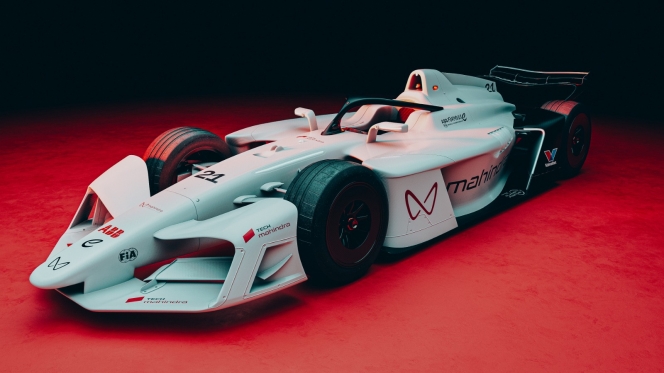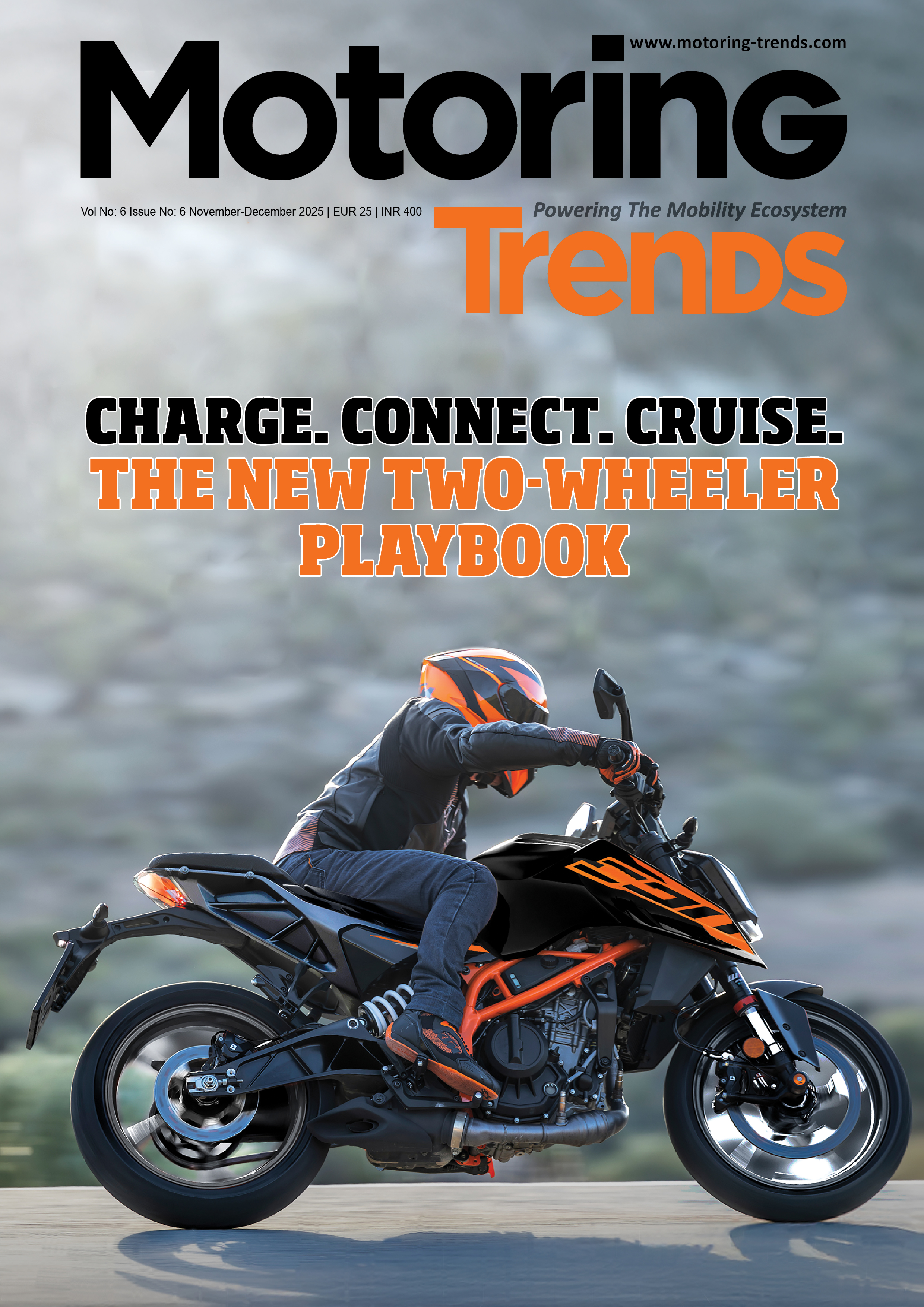India Needs To Invest In Tyre Testing And Labelling Infra: Apollo Tyres CTO
- By Sharad P Matade
- June 22, 2021

The Gurgaon-based tyre major has received accreditation for the wet grip and coast by noise tyre tests on the track. It has already been aggressive in the European market with two manufacturing plants and one R&D centre. With investments, Apollo Tyres is ramping up its testing capabilities to develop tyres for across the segments, including premium passenger, commercial vehicles, high-end motorcycles and off-highway tyres. “The tyre manufacturers are depending on the international labs for advanced characterisation and labelling tests specific to tyres. Thus, investment in both advanced tyre testing as well as labelling infrastructure is needed in this country for quick product development, not only for compliance to latest Indian regulations but also to meet the stringent regulations in other countries and thereby promoting tyre export,” says Daniele Lorenzetti, Chief Technology Officer, Apollo Tyres Ltd in an interview with Motoring Trends.
 Last month, Apollo Tyres became the first Indian tyre manufacturer to get the coveted accreditation from NABL for outdoor labelling tests in India. The company has now been accredited with ISO/IEC 17025 for the wet grip and coast by noise tyre tests on the track. This accreditation is extended for testing different tyre categories for vehicles such as passenger, light truck, commercial (C1, C2 & C3) classes, farm and motorcycle. This testing capability is linked to the Indian government’s plan to implement the ‘Star Rating’ of tyres, in line with the tyre labelling regulation in Europe.
Last month, Apollo Tyres became the first Indian tyre manufacturer to get the coveted accreditation from NABL for outdoor labelling tests in India. The company has now been accredited with ISO/IEC 17025 for the wet grip and coast by noise tyre tests on the track. This accreditation is extended for testing different tyre categories for vehicles such as passenger, light truck, commercial (C1, C2 & C3) classes, farm and motorcycle. This testing capability is linked to the Indian government’s plan to implement the ‘Star Rating’ of tyres, in line with the tyre labelling regulation in Europe.
According to Daniele Lorenzetti, Chief Technology Officer, Apollo Tyres Ltd, the growing focus of the automobile manufacturers on fuel efficiency, higher performance on ride and comfort, and safety is fuelling demand for more tyre component level testing. “Light-weighting in automobiles can alter transfer path for noise and vibration into the cabin, calling for corresponding modification in tyre design. Along with the introduction of AIS 142 standard, similar to EU R117 for labelling of the tyre, huge outdoor testing infrastructure is required, especially in proving grounds,” said Lorenzetti.
Electric Vehicle (EV) related challenges of higher weight, NVH concern, higher torque requirement and subsequent wear rate and battery life would be substantial concerns to tackle during the development process, stated the Apollo Tyres executive. “Similarly, for reducing the number of physical tests, simulation and modal development need to be evolved. Adequate testing infrastructure for validation of simulation and advanced characterisation is also simultaneously required. Hence, more indoor advanced testing infrastructure is required for NVH (Noise, Vibration and Harshness), F&M (Force and Moment) and traction performance validation,” added Lorenzetti.
Today, safety and convenience features are not limited to premium vehicles but are also provided in mid-level and entry-level vehicles, and the same trend is evident in India. Hence, while increasing capability, testing capacity also needs to be enhanced, thinks Lorenzetti.
Indian tyre manufacturers and testing services have basic levels of testing capacity such as safety requirements, durability, braking strength and dimensions. With the Indian government’s NATRIP (National Automotive Testing and R&D Infrastructure Project), vehicle and component level testing facilities have improved. “The tyre manufacturers are depending on the international labs for advanced characterisation and labelling tests specific to tyres. Thus, investment in both advanced tyre testing and labelling infrastructure is needed in this country for quick product development, not only for compliance to latest Indian regulations but also to meet the stringent regulations in other countries and thereby promote tyre export,” explained Lorenzetti.
Like the automobile industry, the tyre industry’s evolution at a broader level depends on economic, social, cultural, technological and climatic changes. The Indian tyre Industry is also evolving with the Indian macro-economic growth, advancements in technology, increasing emphasis on sustainable environmental practices and policy, and institutional and regulatory requirements.
Currently, the tyre industry is going through a highly challenging period, with lockdowns across Indian states owing to the second wave of the Covid-19 pandemic. While this impacts the demand side, pressure on the margin front is also felt due to the rising raw material prices.
 However, with the Indian government’s reinvigorated policies and programmes such as “Atmanirbhar Bharat”, localisation push, EV subsidy, economic stimulus package to thwart pandemic crisis and vehicle scrappage policy, the automotive industry in India is poised to grow at a higher trajectory. “Shift in customer preference to private vehicles from public transport and shared mobility owing to Covid might also generate an uptick. We are optimistic with the and its positive effect on the tyre industry,” said Lorenzetti.
However, with the Indian government’s reinvigorated policies and programmes such as “Atmanirbhar Bharat”, localisation push, EV subsidy, economic stimulus package to thwart pandemic crisis and vehicle scrappage policy, the automotive industry in India is poised to grow at a higher trajectory. “Shift in customer preference to private vehicles from public transport and shared mobility owing to Covid might also generate an uptick. We are optimistic with the and its positive effect on the tyre industry,” said Lorenzetti.
Tyre technology is also evolving in tandem with the automobile industry to pursue higher fuel efficiency, higher performance, driver safety, vehicle stability, light-weighting and heavy load carrying capacity. Additional advanced features such as vehicle connectivity and electrification of functions are also taking place at OEMs, which calls for intelligent talking tyres.
“Unlike in the past, the Indian vehicle market is now fast evolving. Earlier, customers had very few variants/choices available. Now, many models are introduced that call for higher bandwidth of resources. The premium segment is also poised for faster growth, and so comfort, without compromise on traction and durability, is added into the performance requirement list for tyres,” said Lorenzetti.
Indian government’s policies and regulations for sustainable growth are now major drivers for evolution in India. It has already issued a draft notification proposing new tyre norms as a part of the Automotive Indian Standards (AIS) 142:2019. The proposal states that tyres of all cars, buses and trucks shall meet the requirements of rolling resistance, wet grip and rolling sound emissions, in line with the limits of the European regulations.
 Virtual testing is also gaining traction in the auto industry as it saves development time and money and gives flexibility to engineers. Global launches, stiff competition, legal compliance to emissions, demand for more electrification and self-driven vehicles push the development process shorter than ever. The time available for development is becoming shorter and shorter. At the same time, the demands set for the characteristics of a car are becoming increasingly stringent, as is the bandwidth required for various models and variants of vehicles. So, virtual proving is the key to faster product development while tackling tyre testing capacity constraints.
Virtual testing is also gaining traction in the auto industry as it saves development time and money and gives flexibility to engineers. Global launches, stiff competition, legal compliance to emissions, demand for more electrification and self-driven vehicles push the development process shorter than ever. The time available for development is becoming shorter and shorter. At the same time, the demands set for the characteristics of a car are becoming increasingly stringent, as is the bandwidth required for various models and variants of vehicles. So, virtual proving is the key to faster product development while tackling tyre testing capacity constraints.
“However, simulation is as good as its verification and validation. Verification is the process of determining that a model implementation and its associated data accurately represent the developer’s conceptual description and specifications. Validation is the process of determining the degree to which a simulation model and its associated data are an accurate representation of the real world from the perspective of the intended uses of the model. Hence, adequate characterisation testing capability is also simultaneously required for wide-spread application of simulation,” said the CTO of Apollo Tyres.
Apollo Tyres is an Indian company that has been expanding aggressively in the European market. Today, the company has seven manufacturing plants – five in India and two in Europe (Hungary and the Netherlands).
Being a preferred partner for global OEMs, Apollo Tyres is continuously enhancing testing capabilities at its state-of-the-art R&D centres. With the two global R&D centres at Chennai, India and Enschede, Netherlands, the company aims to meet discerning OEM needs. “With the synergies between the two R&D centres, and its advanced testing capabilities, we continuously develop winning products and new technologies while also being at the forefront of meeting new regulatory requirements,” said Lorenzetti.
 The company’s extensive investments in tyre testing not only help it in developing tyres for premium luxury passenger and commercial vehicles but also high-end motorcycles and off-highway tyres (OHT). “At our R&D centre, characterisation capabilities are continuously developed for the determination of traction, NVH, F&M, ride and handling, comfort, tread wear, fuel efficiency, durability and footprint,” added Lorenzetti.
The company’s extensive investments in tyre testing not only help it in developing tyres for premium luxury passenger and commercial vehicles but also high-end motorcycles and off-highway tyres (OHT). “At our R&D centre, characterisation capabilities are continuously developed for the determination of traction, NVH, F&M, ride and handling, comfort, tread wear, fuel efficiency, durability and footprint,” added Lorenzetti.
Automotive test centres with large proving grounds funded by the Indian government are already evolved in India. Its NATRIP project aims to create core global competencies in the automotive sector in India by facilitating seamless integration of the Indian automotive industry with the world through setting up of state-of-the-art automotive testing, homologation and R&D infrastructure facilities.
Collaborations at various levels are also taking place to further enhance the vehicle test centres to tyre-specific test facilities. Earlier, Apollo collaborated with one of the test centres of the Indian government to pioneer the indigenisation of tyre labelling and certification tests in India. Similar collaboration would be beneficial for the industry to evolve faster.
“While large vehicle OEMs have their own limited proving grounds, the massive investment and maintenance requirement for this kind of infrastructure may be challenging for tyre companies to set up. Though collaboration among leading tyre companies would be a welcome scenario, the scale and size of the industry need to be evolved for such a tie-up,” said Lorenzetti.
The EV segment brings its own challenges with the higher weight of vehicles, NVH concern due to fewer and lesser noisy components, higher torque requirement and subsequent wear rate, and battery life. Apollo Tyres is gearing up for the same with capital intensive testing facilities such as “flat track” for traction, F&M tests and hemi-anechoic chamber for NVH tests. Apollo Tyres’ test machines are specially designed with multiple features, such as the very high torque ramp-up rate to match the futuristic EV requirements.
“It is heartening to note that major premium OEMs wholeheartedly partner with Apollo Tyres for joint development of products, featuring advanced technologies and engineering. We are committed in our endeavour to be the trusted partner for our esteemed customers and society at large by enhancing value with best-in-class efficiency through sustainable models for environment conservation,” said Lorenzetti. (MT)

- Hagerty UK
- Vehicle Excise Duty Exemption
- VED Exemption
- Historic & Classic Vehicles Alliance
- Classic Cars
UK Chancellor Maintains Vehicle Excise Duty Exemption For Classic Cars
- By MT Bureau
- November 27, 2025

The UK's cherished classic car community can finally breathe a collective sigh of relief. The decisive action by Chancellor Rachel Reeves in the Autumn Budget to maintain the Vehicle Excise Duty (VED) exemption for vehicles over 40 years old has ended a prolonged period of uncertainty, securing a stable future for this vital sector. Mark Roper, Managing Director of Hagerty UK, welcomed this clarity, noting that the confirmed freeze on fuel duty further solidifies a supportive environment for owners. He underscores that this is a significant win for the GBP-7.3-billion industry that supports over 100,000 jobs and contributes GBP 3 billion annually to the UK economy, all while championing an inherently sustainable form of motoring.
This perspective on sustainability is reinforced by Dale Keller, CEO of the Historic & Classic Vehicles Alliance (HCVA), who affirms that the tax exemption logically aligns with environmental objectives. Classic vehicles, preserved as moving heritage, have a negligible lifecycle carbon footprint compared to new manufacturing and are driven infrequently. The original principle of the exemption remains valid, as applying a modern tax to these rarely used assets would be inequitable.
Alongside the VED news, the Chancellor confirmed the continuation of the MOT exemption for classic cars, though this will remain under review. On this point, Roper of Hagerty UK strikes a note of caution, observing that many within the industry advocate for an annual roadworthiness check. He notes that a great number of responsible classic owners voluntarily submit their vehicles for an MOT each year, valuing the independent assurance of safety and mechanical integrity it provides.
For Hagerty UK, as a specialist insurer deeply embedded in this world, the government’s affirmation is a powerful endorsement of the sector's cultural and economic value. Through its vibrant Clubhouse at Bicester Heritage and unique events like RADwood, Hagerty is actively fostering this passionate community. Similarly, the HCVA continues its mission to protect and promote the diverse ecosystem of specialists, restorers and businesses that form the backbone of this multi-billion-pound industry, ensuring its legacy for generations to come.
Mahindra Racing Extends Formula E Involvement With GEN4 Manufacturer Commitment
- By MT Bureau
- November 26, 2025

Mahindra Racing has solidified its long-term future in electric motorsport by confirming its manufacturer commitment to the GEN4 era of the ABB FIA Formula E World Championship, starting in 2026/27. This announcement, made during the unveiling of its new M12Electro race car in India, extends a relationship that began in 2013 when Mahindra stood as both a founding team and the first OEM to join the all-electric series.
The team's current trajectory underscores the significance of this pledge. Following a dramatic 18-month transformation under CEO and Team Principal Frederic Bertrand, Mahindra Racing has evolved from a backmarker into a consistent front-runner. This resurgence was powered by the redesigned M11Electro, in which drivers Nyck de Vries and Edoardo Mortara collectively secured five podium finishes in Season 11, catapulting the squad to a stellar fourth place in the world championship. The newly launched M12Electro is the intended vehicle to maintain this status as a top-five contender and a regular threat for podium positions in the forthcoming season.
The technical landscape for GEN4 promises to further electrify the sport. The next-generation cars will boast a peak race power of 450 kw, with a potent 600 kw available in ATTACK MODE to empower aggressive overtaking. Enhanced strategic possibilities will come from a race energy capacity of up to 55 kWh and a remarkable 700 kw of regenerative braking. In a continued commitment to sustainability, the GEN4 chassis will be produced from 100 percent recyclable materials and will feature two distinct aerodynamic configurations – high-downforce for qualifying and low-downforce for races – to optimise performance.
Mahindra's ambition is to leverage this new regulatory chapter to build on its renewed momentum, chase incremental gains and establish itself as a confirmed championship contender against elite manufacturers like Porsche and Jaguar. This competitive platform also serves a broader purpose, aligning with the Mahindra Group’s sustainability initiatives. The team, the first in Formula E to earn the FIA’s Three-Star Sustainability Accreditation, has embarked on its ‘Planet Positive’ programme. This initiative is dedicated to driving positive impact in communities and economies, accelerating climate solutions and using the intersection of sport and technology as a catalyst for a better future.
R Velusamy, Chairman, Mahindra Racing, said, "Mahindra Racing has always been a symbol of our commitment to the Race to Road journey – where cutting-edge innovation on the track directly shapes the clean, intelligent and high-performance mobility solutions we deliver to customers. Formula E is a powerful platform for innovating new technology, giving us the ability to experiment, learn and advance electric powertrain efficiency, sustainable materials and software intelligence. As we step into the GEN4 era, our ambition only grows stronger. Continuing this journey till 2030 is a testament to our belief in the sport, in electrification and in India’s role in leading global sustainable mobility. We are proud to champion this future, and GEN4 represents an exciting new chapter for Mahindra Racing and the Mahindra Group.”
Frederic Bertrand, Team Principal, Mahindra Racing, said, “I’m delighted to share this announcement that Mahindra Racing will remain in Formula E as a manufacturer for the GEN4 era. As a team, we have been on a fantastic journey over the past two seasons. What we have built and achieved as a group has been exceptional, and with this announcement, we now have the platform to keep growing and developing and achieve even greater success in the future. None of this would be possible without our colleagues across the Mahindra Group. They have bought into the project and the vision, and we will keep working hard to not only make India proud but also showcase exactly why it has the potential to be a major player on the world stage in the automotive and technology industries. Their enthusiasm to ‘Scream Electric’ is hugely inspiring to the whole team, and we will continue to represent them with pride in this next exciting chapter of our Formula E story in the coming years.”
Jeff Dodds, CEO, Formula E, said, “We’re thrilled to confirm Mahindra’s long-term commitment to the GEN4 era of the ABB FIA Formula E World Championship. As one of our founding teams, Mahindra has been with us since the very beginning, consistently championing electric racing and innovation. Their bold vision for sustainable mobility and continued investment in advanced EV technology perfectly align with Formula E’s mission. Mahindra’s enduring presence not only strengthens our position in a key market but also reinforces Formula E’s role as a global platform for driving positive change. We’re excited to see what they’ll achieve in this next chapter of performance and progress.”
Marek Nawarecki, Senior Circuit Sport Director, FIA, said, “Following the GEN4 reveal and the really positive sentiment reported, we are pleased to announce Mahindra as the sixth manufacturer to commit to Formula E’s GEN4 era. This is testament to the relevance of the road map we are implementing in Formula E for OEMs. GEN4 underscores just how far the ABB FIA Formula E World Championship has come since 2014 and we are looking forward to continuing this journey with Mahindra as one of the founding teams and partners.”
Mahindra Charts Aggressive Decade Of Growth Across Auto, Farm, CV And Last-Mile Mobility Businesses
- By MT Bureau
- November 21, 2025

Mumbai-headquartered conglomerate Mahindra Group has unveiled an ambitious long-term roadmap across its core mobility and equipment businesses, detailing plans for accelerated growth in the automotive, farm equipment, commercial vehicle and last-mile mobility segments.
The strategy, presented at its Investor Day 2025, underscores the Group’s intent to leverage India’s expanding economy while deepening global market participation.
Mahindra expects its consolidated automotive business to grow 8x between FY2020 and FY2030, driven primarily by a stronger push in sports utility vehicles (SUVs) and light commercial vehicles (LCVs).
The company aims to become the world’s fastest-growing SUV brand. Its product strategy is rooted in new-age platforms such as INGLO and NU_IQ, enhanced digital architecture under MAIA and Adrenox, and continued investment in safety and performance.
At present, Mahindra holds more than 26 percent revenue share in India’s SUV segment as of the first half of FY2026. Strong consumer traction for models including the Thar, XUV700, XUV3XO and the Born Electric (BE) series is expected to support the company’s international expansion to right-hand-drive and left-hand-drive markets across Europe, Australia, Africa and other regions.
Strengthening leadership in LCV segment
The LCV business, where Mahindra commands 54.1 percent volume share in vehicles under 3.5 tonnes (as of H1 FY2026), is set to be another pillar of growth. The product range has broadened through the Supro, MaXX and Veero platforms, including CNG and electric variants. The company is also preparing for wider adoption of lifestyle pickups, led by the upcoming Global Pik Up.
Mahindra’s LCV strategy emphasises best-in-class total cost of ownership, reduced downtime, enhanced comfort and technology integration, with the segment also targeted for eightfold revenue growth during the decade.
Farm business
Mahindra, the world’s largest tractor manufacturer by volume, has outlined plans for threefold revenue growth in its farm equipment division between FY2020 and FY2030.
The Indian tractor market has continued to shift towards higher horsepower models, particularly in the 40–50 HP range. Mahindra aims to consolidate share in this segment through newer platforms including Yuvo Tech+, Swaraj Protek and Next-Gen ranges. Improvements in crop profitability and a more favourable price environment for tractors are expected to support industry expansion.
Mechanisation levels in India remain uneven, with significant headroom in sowing, crop care and harvesting equipment. Mahindra is expanding its farm machinery portfolio while leveraging its extensive dealer network and manufacturing footprint. The division, already a business exceeding INR 10 billion, is poised for rapid scaling.
Mahindra continues to build presence in key global markets:
- Brazil: 8 percent share in the sub-120 HP category, and about 20 percent in sub-50 HP
- North America: more than 10 percent share in sub-20 HP; upcoming launches to deepen penetration
- ASEAN: early progress with about 4 percent share in pilot territories
Electrification, autonomy, precision agriculture and pay-per-use technology services form the next frontier for Mahindra’s farm business.
Targeting Top-Three Position in ILCVs
Following the acquisition of SML Isuzu, Mahindra is advancing a strategy to be among the top-three player in India’s intermediate and light commercial vehicle (ILCV) market. The domestic CV industry is projected to grow from approximately INR 15,000 billion in FY2025 to nearly INR 20,000 billion by FY2031, supported by infrastructure development, logistics modernisation and GST-driven reforms.
Mahindra aims to expand its presence in ILCVs, while pursuing a selective play in the heavy commercial vehicle category. The strategy benefits from combined advantages across product development, sourcing, aggregates, telematics and network coverage. The company expects up to sixfold revenue growth in its CV business during the decade.
Last-Mile Mobility
Mahindra Last Mile Mobility (MLM) is shaping an aggressive electrification-led growth plan, targeting sixfold revenue expansion and a cumulative one million electric vehicles on the road by 2031. EV sales climbed to 78,678 units in FY2025, led by the Treo series, which remains India’s top-selling electric three-wheeler.
The division has:
- Strengthened its engineering capabilities with a 400-member product development team
- Commissioned a new state-of-the-art manufacturing plant in Telangana
- Expanded production capacity two-fold
- Developed proprietary battery, motor and telematics systems
The product roadmap includes advanced electric three-wheelers and electric four-wheelers tailored for last-mile applications, along with plans to expand exports to more than ten markets. Mahindra’s EV fleet has cumulatively saved over 300 million litres of fuel and prevented more than 185 kilo tonnes of carbon dioxide emissions.
Across all mobility segments, Mahindra’s plan is anchored in product leadership, technology integration, capital discipline and global expansion. A stronger focus on electrification, platform consolidation, digital interfaces, manufacturing efficiency and customer-centric service models is expected to underpin the Group’s growth trajectory.
- Murugappa Group
- Arunachalam Vellayan
- Coromandel International
- EID Parry
- EXIM Bank
- Kanoria Chemicals & Industries
- Indian Overseas Bank
Murugappa Group’s Former Chairman Arunachalam Vellayan Passes Away At 72
- By MT Bureau
- November 18, 2025

Chennai-based conglomerate Murugappa Group has announced the passing of Arunachalam Vellayan (1953–2025) following an illness.
Vellayan was the Chairman Emeritus of Coromandel International and the Former Chairman of the Murugappa Group. He is survived by his wife, Lalitha Vellayan, his sons, Arun Vellayan and Narayanan Vellayan, and his grandchildren.
The Former Chairman dedicated several decades to the Group, providing strategic direction across its businesses. His approach to value creation helped strengthen and expand the Group, contributing to its reputation as a respected conglomerate.
He served on the Boards of various Murugappa Group companies, including as Chairman of Coromandel International and EID Parry.
Outside the Group, he served on the Boards of entities such as Kanoria Chemicals & Industries, EXIM Bank and Indian Overseas Bank.






Comments (0)
ADD COMMENT